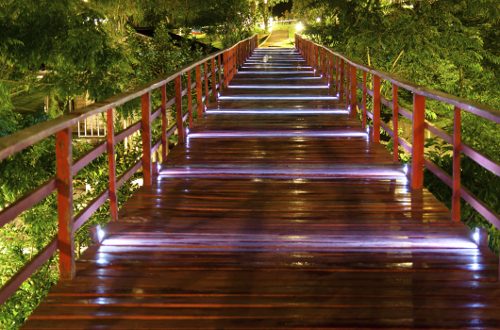One of the most useful and noticeable places to stick outdoor lighting around your home is on and around your walkways. Walkway lighting provides you with safety from tripping over stairs and uneven pavement at night and can make your home look striking when done right. Here are a few of the best fixtures that you can use as well as ways that you can install them to make you pathway lighting eye-catching.
Solar Walkway Lighting
One of the most popular options for many homeowners are solar walkway lights.
These lights are easy to install and easier to manage. Since you don’t need to run any wires to install them or plug them into your home, all that you need to do to install them is order the right fixtures that you want, assemble the fixtures and place around the edges of your walkway.
The downside to these lights is that they generally don’t work well in shady conditions. This makes them great for driveway lighting and other areas where there tends to be direct exposure to sunlight, but less than suitable for any paths or other areas that you have that are covered by shade for large parts of the day. They can still work in these areas, but most lights will be dimmer, won’t burn as long, and the batteries that store the power will usually wear out quicker.
Check: Tips for lighting: Wide every space in your home
Low Voltage Walkway Lights
Your other option for outdoor walkway lighting is to install low voltage lights. With these lights, you need a landscape lighting transformer that converts the power from the shockingly dangerous 120 volts that runs into your house to a friendlier 12 or 24 volt current. This way, you can install the lights yourself and not have to worry about burying the wires or shocking anyone.
These are a little bit harder to install since you have to run and hide the power cables to prevent tripping. However, installing these lights is simple enough that almost any homeowner can do it.
The major disadvantage to these lights is that the longer you run the cable, the more voltage drop you will get and the lights at the end of the cable will be dimmer.
This can be overcome by getting a more powerful transformer or running heavier cable, but it still makes running the wires a long distance somewhere problematic. Because of this, these lights are best for areas around the home, like stairs, decks, and patios or other areas that are close to outdoor plugs.
Installing Walkway Light Fixtures Professionally
There are numerous popular walkway light fixtures that you can use that professionals use as well. Mushroom lights are always a great options, as are paver kits, to give you walkways a professional finish. The biggest difference isn’t what fixtures professionals install, but how they install them.
To install your lights better, what you need to do first is figure out how big of a circle of light each fixture you have casts. The radius of the circle will tell you how far apart each light needs to be placed and if you divide by the length of the path you want to light, you can figure out exactly how many fixtures that you need. The fun part is next – search online to find some great looking fixtures for your property.
When you get your lights, install them by placing them equal distances apart on opposite sides of your path. This avoids the runway look that you tends to happen when you place the lights all on one side and is exactly the way professionals install their lighting.
Installing professional looking low voltage or solar pathway lighting is a great way to make your home not only safer, but also more eye-catching as well.
